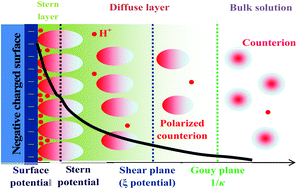A how-to approach for estimation of surface/Stern potentials considering ionic size and polarization
Abstract
Electrostatic potential in the electric double layer is an important parameter that significantly affects a large number of physical, chemical and biological properties and processes. In the present study, a new approach for the estimation of surface potential and Stern potential considering ionic volume and polarization was developed. Ionic strong polarization in the diffuse layer increases its effective charge and determines the Stern potential, while ionic volume in the Stern layer strongly decreases its effective charge and determines the surface potential. For example, the effective charge of K+ is increased by 0.699 (from 1 to 1.699) resulting from polarization, while it is decreased by 1.359 (from 1.699 to 0.240) due to finite size. The determined surface potential is about 7 times as high as the Stern potential. The effects of volume and polarization on the surface/Stern potentials were quantified respectively, and the former was stronger than the latter. A new theory was verified by the experiments for aggregates stability. The present work also showed that only introduction of the strong polarization into the DLVO theory can describe the interactions of colloidal particles.


 Please wait while we load your content...
Please wait while we load your content...